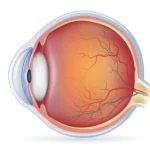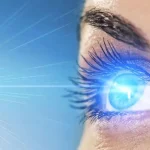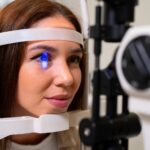Table of Contents
- What Is AI in Eye Care?
- How AI Diagnoses Common Eye Conditions
- Benefits of AI Diagnostics in Eye Disease
- Integration With Telemedicine and Screening Programs
- AI in Surgical Planning and Post-Op Monitoring
- Potential Risks and Ethical Considerations
- The Future of AI in Ophthalmology
- Conclusion
- FAQs
What Is AI in Eye Care?
Artificial intelligence (AI) has made a breakthrough in the medical industry, including ophthalmology. As diagnoses and therapeutic monitoring rely heavily on image monitoring, the application of AI is promising for its accuracy. One such example is how AI algorithms are analyzing retinal images, OCT scans, and visual fields to detect early stages of diabetic retinopathy, glaucoma, and macular degeneration.
In this blog, we will explore the role of AI-powered diagnostics in eyecare, its benefits, the role of AI in surgery, and its potential risks.
How AI Diagnoses Common Eye Conditions
AI-driven diagnostics and procedures are now making early detection and treatment of eye diseases faster, more accurate, and more accessible. Let’s have a look at how AI is helping diagnose serious eye ailments.
- Diabetic retinopathy: According to a study, the number of diabetic patients prone to developing diabetic retinopathy is increasing steadily and is projected to reach 242 million by 2045. With the help of deep learning, AI can detect changes in the glucose, lipid profiles, and blood pressure levels of the eyes. This helps the doctors diagnose the issue early and provide treatment on time. It can also provide proper intervention in targeted areas that can prevent the problem from worsening.
- Glaucoma: Glaucoma, another leading cause of irreversible blindness, often progresses silently. Similar to detecting diabetic retinopathy, deep learning can detect any changes in intraocular pressure with accuracy and speed. Hence, patients at high risk can consult with a doctor before they experience any symptoms.
- Age-related Macular Degeneration (AMD): Using AI algorithms to detect drusen, biomarkers, and other subtle changes in the OCT scan, doctors can diagnose Age-related Macular Degeneration (AMD) faster.
Benefits of AI Diagnostics in Eye Disease
The benefits of AI-powered diagnostics for curing eye ailments are manifold. Some of these are listed below:
- Increased accuracy: Trained on huge amounts of datasets, AI can detect the slightest changes in ocular pressure, biomarkers in the eyes and report it accurately for monitoring.
- Early detection and prevention of conditions: AI is gaining popularity in the medical fraternity for its predictive capabilities. Hence, people complaining of itchy eyes or blurry vision can get tested and treated before the problem becomes irreversible.
- Speed and scalibility: As AI algorithms can process millions of image screens within a very short period of time, it makes mass eye screenings in both urban and rural areas quite easy.
Integration With Telemedicine and Screening Programs
AI has paved its way towards telemedicine and screening programs as well. One of the significant benefits of using AI in telemedicine is its accurate diagnostic abilities. Hence, doctors rely on using AI in mobile eye camps and primary care clinics.
Additionally, for scheduling remote consultations, AI plays an important role. Its machine learning algorithms has unburdened doctors from manually scheduling appointments which helps them focus towards patient care more. Also, during a remote consultation, doctors can provide real-time insights into the patient care enabled by the AI system.
AI in Surgical Planning and Post-Op Monitoring
From analyzing medical images to enabling personalized post-operative monitoring and management, AI algorithms are transforming surgical practices.
- Predicting outcomes for cataract and LASIK surgeries: Prior to a cataract/LASIK surgery, AI algorithms can analyze the patient data and images to predict the likely outcomes. It can also detect the potential complications that can arise during the procedure so that the doctor can make informed decisions.
- Customized treatment planning: On the basis of the patient’s personal characteristics and comorbidities, it offered customized surgical plans that can increase the chances of success.
- AI-assisted recovery tracking and complication prediction: After the surgery, AI algorithms can help increase the likelihood of adherence to post-operative guidelines, predict any infections, and facilitate remote patient monitoring.
- One of the important aspects of AI that is being leveraged in eyecare is its pattern recognition ability. Its algorithms are built on large-language modules (LLMs) that can sift through tons of medical images to spot even the smallest signs of disease, and, in turn, recognize a pattern. After that, it compares the data with a huge collection of past cases, helping doctors understand if someone is at low, moderate, or high risk.
- Another important functionality of AI tools is providing automated alerts to ophthalmologists. This not only reduces diagnostic errors but also streamlines patient care.
Potential Risks and Ethical Considerations
It’s important to note here that AI-powered diagnostics comes with its set of potential risks and ethical challenges. Some of them are discussed below:
- Risk of false positives or negatives: While training the AI algorithms, it’s of utmost importance to ensure that the datasets are thoroughly validated and accurate to minimize inaccuracies and false positives/negatives. Or else, inaccurate predictions can lead to incorrect diagnoses and treatment plans, risking the patient’s health.
- Data privacy and consent challenges: As AI is trained with the help of large sets of data, it raises questions regarding maintaining privacy. People are raising concerns about the safety and security of their patient information. To prevent data leakage and miuse of data, doctors and medical experts should put proper data protection protocols in place. Also, people have raised questions for providing proper consent for using their personal data. Proper authorities should inform patients about how AI with assess their data and used it for treatment.
- Reliance on algorithm accuracy over clinical judgment: Although AI is known for its accuracy, one should remember not to depend it on completely for making clinical judgements. AI produced data clubbed with human experiences is the optimum way to provide treatment options.
The Future of AI in Ophthalmology
Its safe to say AI is revolutionizing eyecare fundamentally. Backed by several surveys, experts predict that future of healthcare largely involves AI-driven diagnostics.
Meanwhile, big data plays a crucial for training AI in medical care. Once the big data is being fed to these training modules, deep learning analyzies vast amounts of patient records, eye scans, and treatment outcomes and eventually, identify intricate patterns, leading to more personalized and efficient care solutions.
Globally, doctors are showing interest in using predictive modeling capabilities of AI to assesses and curb progression of any eye disease. AI systems can analyze a patient’s condition and provide a likely outcome of the treatment. This not only allows for earlier treatment option but also reduces the chances of the problem worsening with time.
AI-powered clinical tools is another significant breakthrough. Based on a patient’s earlier test results, medical history combined with the latest knowledge, these tools assist doctors in making informed decisions. Keeping several parameters in check, these specialized tools enable doctors to prescribe accurate treatment options.
Conclusion
In short, AI in eye care is making diagnoses faster, treatment more precise, and saving vision, sometimes even before the patient realizes something is wrong. From smart lenses to specialized data analysis tools, AI is bringing in a new era in eye care. However, human intervention is equally vital while relying on technology. Several authorities are working continuously to ensure that the usage of AI in diagnostics and treatment is done ethically and within regulations.





